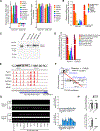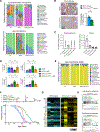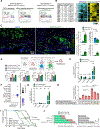Oncogenic collagen I homotrimers from cancer cells bind to α3β1 integrin and impact tumor microbiome and immunity to promote pancreatic cancer
- PMID: 35868307
- PMCID: PMC9831277
- DOI: 10.1016/j.ccell.2022.06.011
Oncogenic collagen I homotrimers from cancer cells bind to α3β1 integrin and impact tumor microbiome and immunity to promote pancreatic cancer
Abstract
In contrast to normal type I collagen (Col1) heterotrimer (α1/α2/α1) produced by fibroblasts, pancreatic cancer cells specifically produce unique Col1 homotrimer (α1/α1/α1). Col1 homotrimer results from epigenetic suppression of the Col1a2 gene and promotes oncogenic signaling, cancer cell proliferation, tumor organoid formation, and growth via α3β1 integrin on cancer cells, associated with tumor microbiome enriched in anaerobic Bacteroidales in hypoxic and immunosuppressive tumors. Deletion of Col1 homotrimers increases overall survival of mice with pancreatic ductal adenocarcinoma (PDAC), associated with reprograming of the tumor microbiome with increased microaerophilic Campylobacterales, which can be reversed with broad-spectrum antibiotics. Deletion of Col1 homotrimers enhances T cell infiltration and enables efficacy of anti-PD-1 immunotherapy. This study identifies the functional impact of Col1 homotrimers on tumor microbiome and tumor immunity, implicating Col1 homotrimer-α3β1 integrin signaling axis as a cancer-specific therapeutic target.
Keywords: immunotherapy; pancreatic cancer; tumor immunology; tumor microbiome; tumor microenvironment; type I collagen.
Copyright © 2022 Elsevier Inc. All rights reserved.
Conflict of interest statement
Declaration of interests The authors declare no competing interests.
Figures








Comment in
-
Untangling the tumorigenic role of homotrimeric collagen I.Cancer Cell. 2022 Aug 8;40(8):802-804. doi: 10.1016/j.ccell.2022.07.007. Cancer Cell. 2022. PMID: 35944498
References
-
- Bhattacharjee S, Hamberger F, Ravichandra A, Miller M, Nair A, Affo S, Filliol A, Chin L, Savage TM, Yin D, et al. (2021). Tumor restriction by type I collagen opposes tumor-promoting effects of cancer-associated fibroblasts. The Journal of clinical investigation 131. 10.1172/JCI146987. - DOI - PMC - PubMed
Publication types
MeSH terms
Substances
Grants and funding
LinkOut - more resources
Full Text Sources
Other Literature Sources
Medical
Molecular Biology Databases
Research Materials
Miscellaneous

